By Falco
02 Oct 2024
It happened – US fed funds rates finally peaked. The Fed’s sprung a small surprise and cut interest rates by 50bps against a marginal majority view that the fed would only cut rates by 25bps. The accompanying statement and dot plot showed that the market was right to anticipate further consistent cuts from future Fed meetings. The peaking of US rates has acted as a catalyst for better performance from equities and bonds as the quarter closed.
Chart 1: The Peaking of the US Fed Funds Rate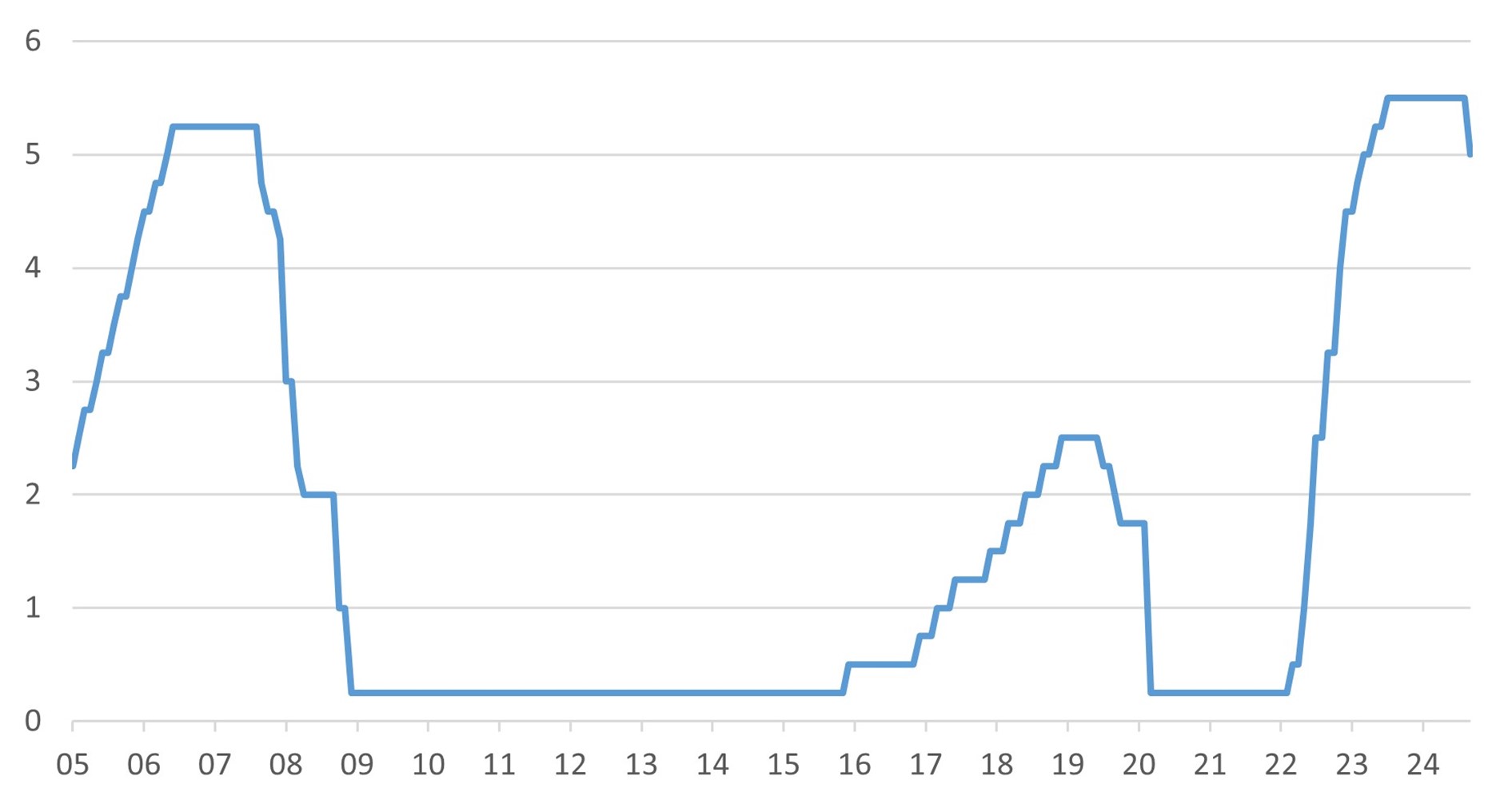
Source: Bloomberg
Global growth and inflation continued to drift lower through the third quarter, with growth and inflation data on average surprising to the downside. Europe remained weak, the US was improving from a mini-slump, and Asia only received a significant stimulus to growth from China late in the quarter. As US interest rates peaked, smaller central banks, including the Bank of Indonesia and the Central Bank of New Zealand, followed suit by cutting their rates.
In analysing economists' growth forecasts, the consensus is that global growth for 2024 will closely mirror that of 2023. For instance, the IMF projects developed market growth of 1.7% for 2024, identical to 2023. Notably, the US stands out due to its high levels of fiscal spending and robust consumer spending, with an anticipated GDP growth of 2.6% for the year.
Chart 2: Global economic surprise – inflation and growth
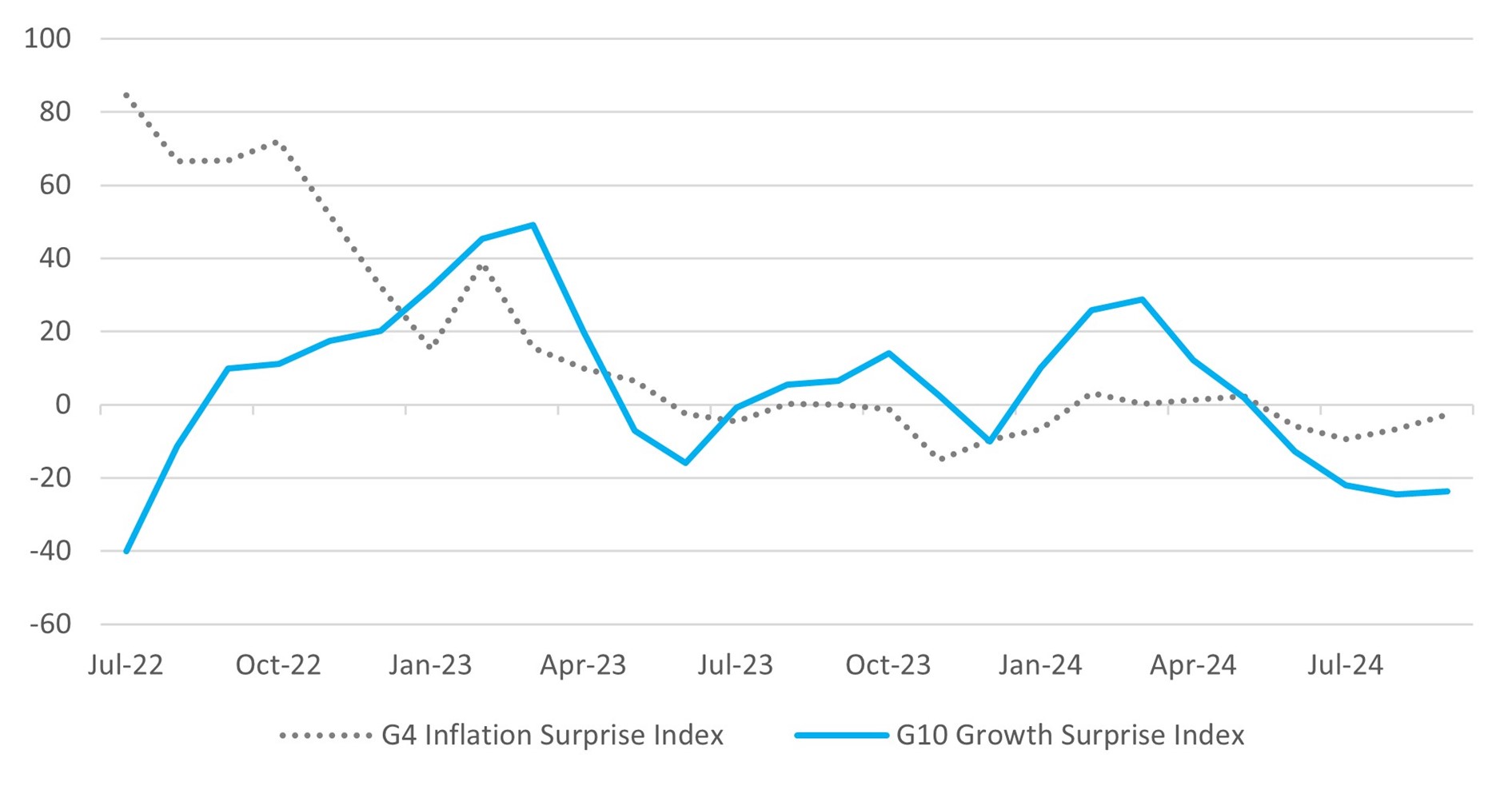
Source: Bloomberg
The notable exception to the still weak growth data from around the world was the United States which showed a sharp improvement in the economic growth data beats from August to late September. Although the data has only just started to surprise to the upside with the US economic surprise index just crossing the zero line.
Chart 3: US Economic Surprise Index shows a Sharp Improvement Late in the Quarter
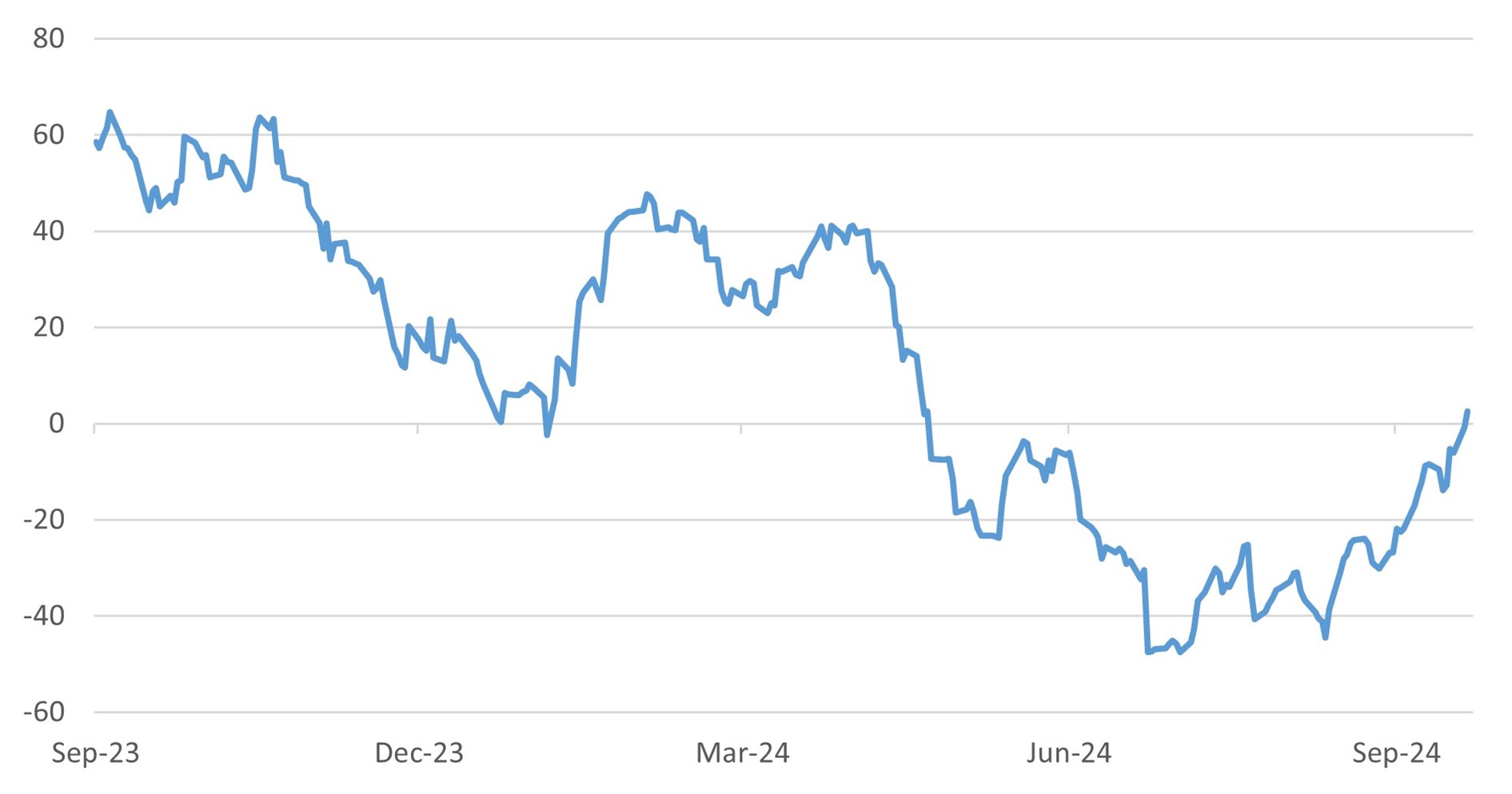
Source: Bloomberg
European growth still appears anaemic, and countries like France are struggling to rein in their fiscal deficit, which currently sits at close to 5.5% of GDP. Germany, Europe's largest economy, looks to have stagnated in 2024, with the leading economic institutes forecasting that GDP will decline again this year by 0.1% after a shrinkage of 0.3% in 2023. The only saving grace may be the potential sharp recovery of the Chinese economy. Germany has quite a substantial trade surplus with China.
The leadership of China finally reacted emphatically to the marked weakness in the economy with a package of significant measures to support household confidence and pour money into the economy. First, the government encourages the rapid utilisation of existing credit facilities to promote growth. In the second phase, JPMorgan estimates that the government will look to deploy a further 1% to 2% of GDP, equivalent to 1-2 trillion Yuan. The final stage, possibly at the turn of the year, would be the so-called big bazooka at 2-4% of GDP; in essence, the government would throw money at the problem.
Chart 4: China’s Consumer Confidence Has Never Recovered from COVID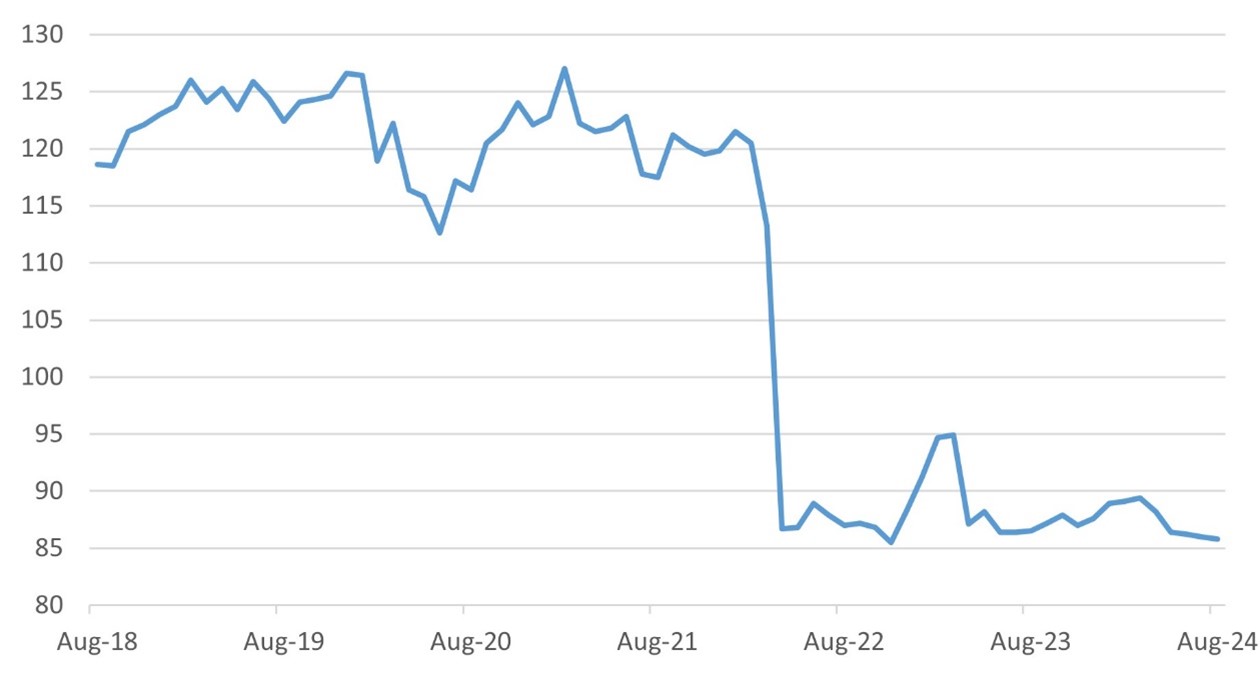
Source: Bloomberg
Elsewhere in Asia the Australian economy shows a mixed picture. Economic growth has been relatively modest, with a GDP growth rate of 1.1% as of June 2024. Hence, the country has been waiting for the central bank to react with interest rate cuts. The Central Bank of New Zealand set the standard by cutting interest rates much earlier than expected. However, the Reserve Bank of Australia is still very cautious about rate cuts, although it has signalled that it is not minded to cut rates even further despite the stickiness of inflation.
Japanese economic growth has been steady, with the pace of growth holding up well to the relief of many economists. The Tankan survey of industrial confidence remained constant through the third quarter despite the high volatility of the yen. The increasing confidence among economists that GDP growth would be stable, wage growth would accelerate, and employment expansion has allowed the central bank to pursue a tightening of monetary policy. The crucial change from the past is the increasing conviction among economists that the improvements in the economy will be maintained.
As the quarter evolved, inflation proved to be a less of a challenge to the global economy and central bankers than economists had previously expected. One supporting factor was the weakness of the oil price which drifted lower through the quarter. Saudi Arabia has in essence decided to defend its market share by increasing production and allowing oil prices to fall further to squeeze other producers out of the market. The drop in oil prices supports the current disinflation evident in inflation data in many places around the world. However as the quarter closed, the geopolitical issues in the Middle East became a greater threat to calm in the oil market
Chart 5: WTI Oil price $bbl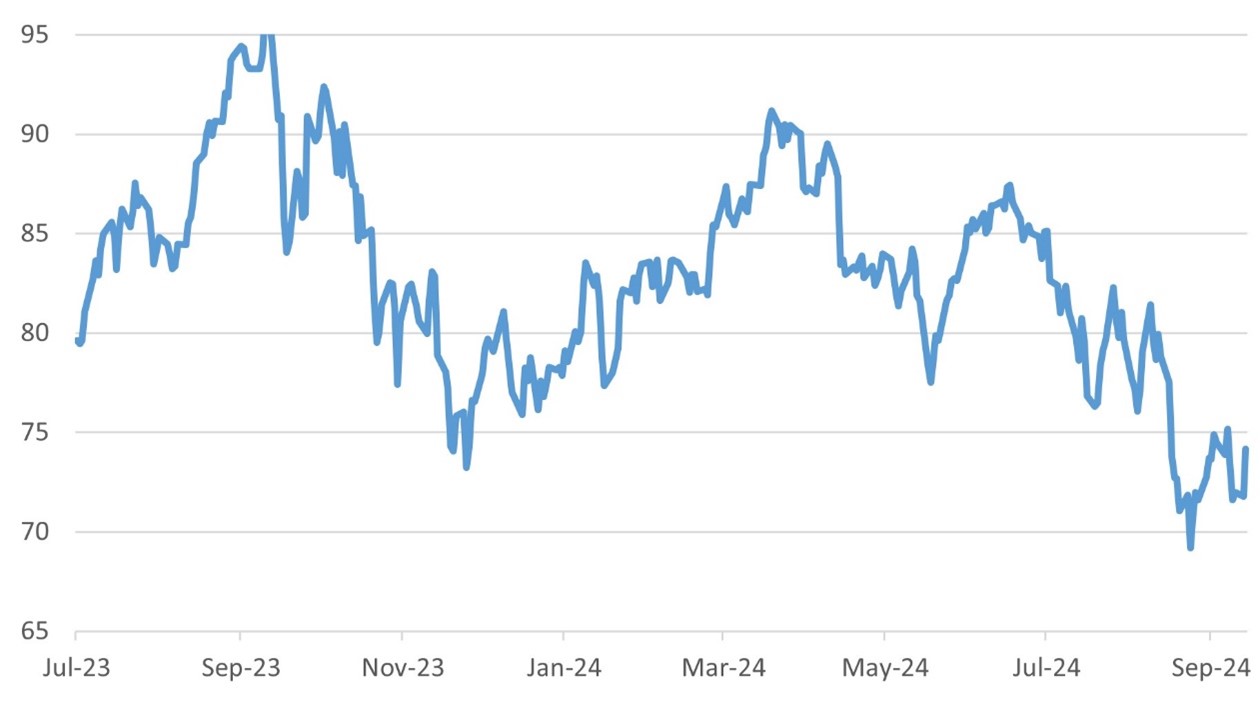
Source: Bloomberg
Into the fourth quarter, investor focus will likely be on the hopes of further meaningful rate cuts by the end of the year. We also have the small matter of the U.S. Presidential election on November 5th. The two candidates represent very different policies but end up at the same place with an ongoing high budget deficit and reasonable growth. The critical difference will be the expected antagonism of a Trump Presidency in the global economy. The Democrats have already applied some significant tariffs and bans on Chinese products. However, a Trump presidency might take this to a whole new level, with consequences for Chinese exports (down) and US inflation (up).
Markets
Equities
For a change, the tech sector did not lead equity market gains over the quarter. The market's focus shifted to the general easing of monetary conditions around the world, bar Japan. The Fed's surprising 50bps asset cut at the end of the quarter helped lift markets after a mid-quarter wobble as market concerns built about a potential recession.
By market factor, high-dividend yield and low-volatility stocks led the market. Income stocks were favoured by investors looking for strong dividends as bond yields fell alongside interest rates.
China was the standout country performance. A significant government stimulus programme targeting a sharp recovery of GDP growth led to the largest single-day rally in the market, 16% since 2008.
A sharp appreciation of the Yen against the dollar provided a headwind to the Japanese equity markets' performance. From the weak Yen of 160 to the dollar at the start of the quarter, the Yen appreciated to a low of 140 as the Bank of Japan indicated its intent to raise rates over an extended period of time.
Table 1: Equity Market Returns
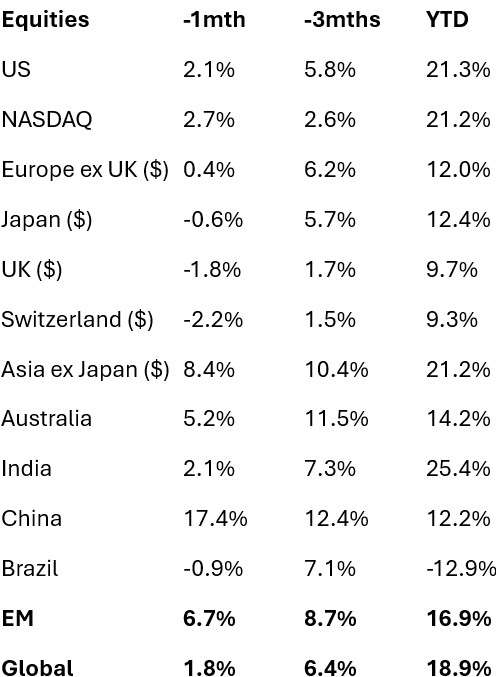
Source: Bloomberg
Tech and the energy sectors were principle sector laggards in the quarter as investor focus shifted to stocks and sectors that benefit from lower interest rates. The energy sector was hampered by a setback in oil prices as OPEC+ struggled to control supply as oil demand weakened. The IT sector had fewer positive headline earnings reports. NVIDIA failed to excite after a delay to the launch of one of their new products. Other Mag7 stocks also failed to live up to analyst expectations.
Table 2: Equity Market Returns by Sector ($)
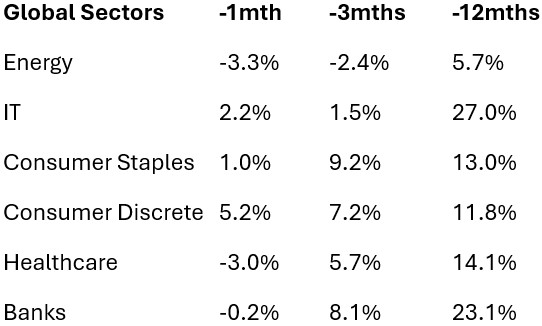
Source: Bloomberg
Bonds
Bonds gave good returns over the quarter as the market began to discount the prospect, and then the delivery of an outsize rate cut from the Fed. Rate cuts across the developed world, many cuts before the Fed acted, all led to bond yields falling across the yield curves. Credit and emerging markets largely followed the lead of government bonds, with spreads largely unchanged over the quarter. Indeed spreads remain low by historic standards.
Table 3: Bond market returns (%)
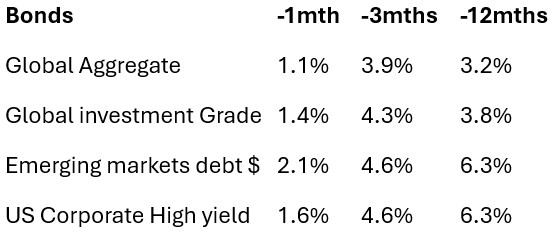
Source: Bloomberg
FX and Precious metals
The decline in US interest rates led to a fall in the trade-weighted dollar, contributing to a rise in gold prices. The euro traded sidewards as the ECB still showed a reluctance to accelerate rate cuts despite the Fed's example.
Gold's strong absolute gains were in part due to lower US rates but also to increasing investor concern about Middle East geopolitical matters.
Table 4: Precious metals and currencies
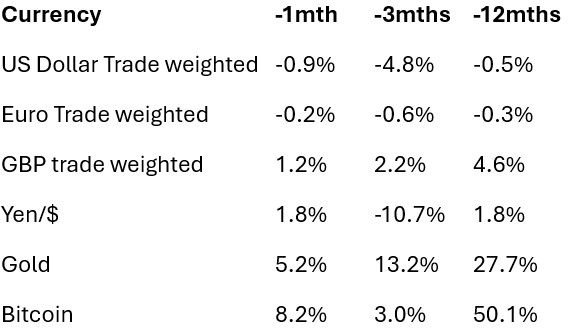
Source: Bloomberg
Gary Dugan - Investment Committee Member
Bill O'Neill - Non-Executive Director & Investor Committee Chairman
2nd October 2024
The information contained within is for educational and informational purposes ONLY. It is not intended nor should it be considered an invitation or inducement to buy or sell a security or securities noted within nor should it be viewed as a communication intended to persuade or incite you to buy or sell security or securities noted within. Any commentary provided is the opinion of the author and should not be considered a personalised recommendation. The information contained within should not be a person's sole basis for making an investment decision. Please contact your financial professional at Falco Private Wealth before making an investment decision. Falco Private Wealth are Authorised and Regulated by the Financial Conduct Authority. Registered in England: 11073543 at Millhouse, 32-38 East Street, Rochford, Essex SS4 1DB
